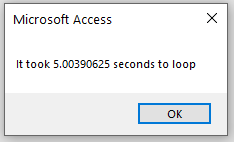VBA – Wait, Delay, Create a Timer While Running Code
In this Article
Wait or Delay in VBA
There are many instances when a timer could be useful in Excel, here is one method to try:
Sub MyTimer()
Application.Wait Now + TimeValue("00:00:05")
MsgBox ("5 seconds")
End Sub
 A couple uses of a timer in Excel VBA are pausing code and measuring elapsed time. The following will take you to the respective place I’ve posted an example of each use:
A couple uses of a timer in Excel VBA are pausing code and measuring elapsed time. The following will take you to the respective place I’ve posted an example of each use:
1. Pause code execution for a desired amount of time with Application.Wait (simulating a timer)
link: Hide Excel
2. Measure elapsed time with a Timer in VBA
link: Benchmarking Code
Wait or Delay in Access VBA
You can also use the methods above in Access VBA. For example, you might like to know how long it takes to move through a recordset.
Sub LoopThroughRecords()
Dim Count As Long
Dim BenchMark As Double
BenchMark = Timer
'Start of Code to Test
Set dbs = CurrentDb
Set rst = dbs.OpenRecordset("tblInvoices", dbOpenDynaset)
With rst
Do Until .EOF = True
.MoveNext
Loop
End With
'End of Code to Test
MsgBox "It took " & Timer - BenchMark & " seconds to loop"
End Sub